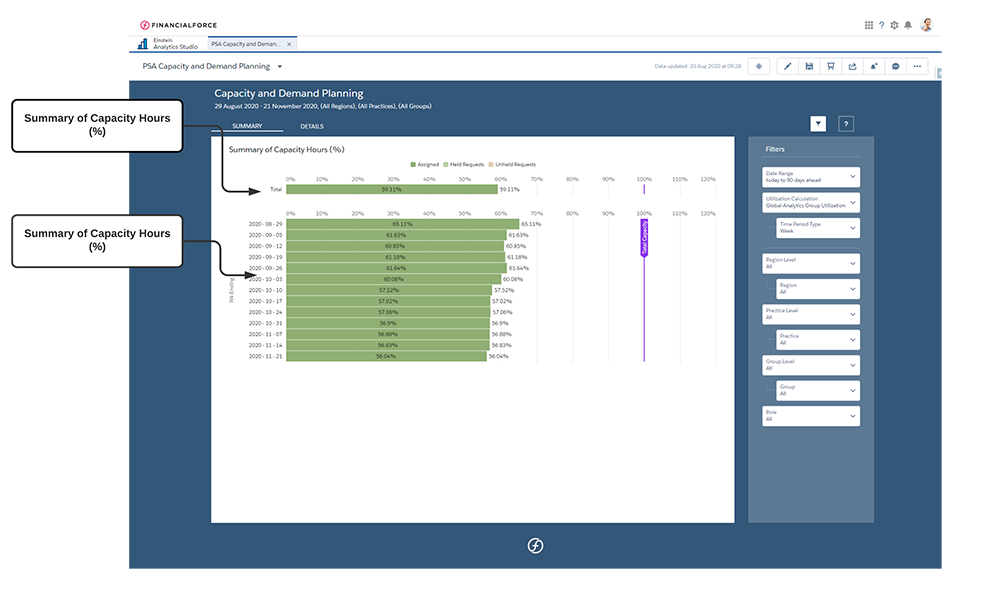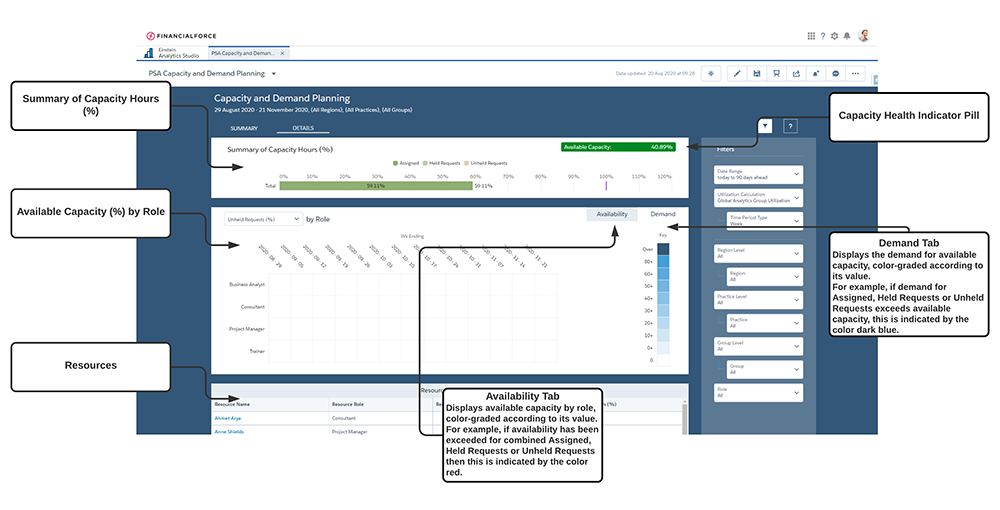PSA Capacity and Demand Planning Dashboard
The PSA Capacity and Demand Planning dashboard displays data from the Capacity dataset.
The dashboard is created as part of the PS Cloud Advanced Analytics app.
This dashboard enables you to:
- View demand and capacity of roles by Region, Practice or Group.
- View a breakdown of capacity for your selected date range by Assigned, Held Requests, Unheld Requests and Available Capacity.
- View resources and their capacity hours for your selected date range and role.
- Drill through to view details of resources in PSA.
Suggested Use Case
You want to see if you have enough capacity to cover demand, including your unheld resource requests. Use the dashboard to review how this demand affects your capacity by role, and how you might fulfill this demand with available resources.
The calculations used in this dashboard use fields derived from the Utilization Summary object and Utilization Detail objects. In order to use this dashboard, you must configure PSA to create utilization summary records. For more information see Utilization Settings in the PSA Help.
Data Structure
The data displayed in the PSA Capacity and Demand Planning dashboard is organized using the following types, subtypes and measures:
|
Scheduled Scheduled Held |
Unheld |
Remaining |
|
|---|---|---|---|
|
Type:
Subtype:
Measure:
*Derived from the Utilization Summary object. |
Type:
Subtype:
Measure:
|
Type:
Measure:
|
|
PSA Capacity and Demand Planning Dashboard
Refer to the schematics below for details of dashboard elements.
The dashboard displays data from the Capacity dataset. For more details about the fields used in the dashboard calculations, see Billings Dataset PS Cloud Analytics Output Fields.
PSA Capacity and Demand Planning Dashboard Pages
The dashboard contains the following pages and tabs:
- Summary
- Details. Contains the tabs Availability and Demand.
PSA Capacity and Demand Planning Dashboard Charts
The PSA Capacity and Demand Planning dashboard contains the following charts:
Faceting is not applied between charts displayed on different pages and tabs in this dashboard. You can only facet between charts on the same page and tab.
For example, faceting applied to charts on the Availability tab on the Details page are not applied to the Demand tab on the Details page.
For more information about dashboard functionality, see Using the Dashboards Charts.
Drilling Through to Resources
To drill through to view details of resources in PSA from the Resources table:
- Hover over a cell in the Resource Name column in the table.
- Click the
 that appears, then click Open Record.
that appears, then click Open Record. - The related resource opens in a new PSA tab.
Filters
The following filters are available on the PSA Capacity and Demand Planning dashboard. For more information about the dataset fields that provide the values for some of the dashboard filters, see Billings Dataset PS Cloud Analytics Output Fields.
|
Name |
Description |
Source of Filter Options |
|---|---|---|
|
Date Range |
Select a specific time period to filter by, or select "Custom" to create your own time period to filter by. |
Filtered by the Time Period End Date dataset field, but the value from the Time Period Name dataset field is displayed in the picklist. |
| Group | Select the specific groups to filter by, and apply the relevant operators to include or exclude them from the displayed data. | Dataset field: Group Name |
| Group Level | Select the specific group levels to filter by. Selections determine the options displayed in the Group filter. | Dataset field: Group Level XX, where XX represents a number between 00 and 12. |
| Practice | Select the specific groups to filter by, and apply the relevant operators to include or exclude them from the displayed data. | Dataset field: Practice Name |
| Practice Level | Select the specific practice levels to filter by. Selections determine the options displayed in the Practice filter. | Dataset field: Practice Level XX, where XX represents a number between 00 and 12. |
| Region | Select the specific groups to filter by, and apply the relevant operators to include or exclude them from the displayed data. | Dataset field: Region Name |
| Region Level | Select the specific region levels to filter by. Selections determine the options displayed in the Region filter. | Dataset field: Region Level XX, where XX represents a number between 00 and 12. |
| Role | Select the specific resource roles to filter by. | Dataset field: Resource Role |
| Time Period Type | Select a specific time period type to filter by. Only the time period types for the selected utilization calculation are available for selection. | Dataset field: Time Period Type |
| Utilization Calculation | Select the specific utilization calculations to filter by. By default, only utilization calculation records with the Is Report Master field selected are available for selection. If required, you can select multiple utilization calculations, but you must ensure that your calculations are configured appropriately to avoid double counting. | Dataset field: Utilization Calculation Name |
For more information about dashboard functionality, see Using the Dashboards Charts.
 SECTIONS
SECTIONS
